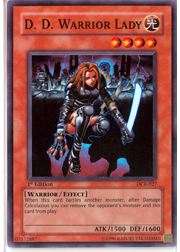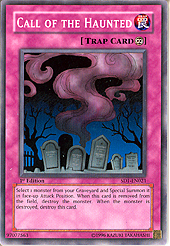Take a look at the cards in your deck—it’s a safe bet that nearly all of them have effects of some type. Monster cards, spell cards, and trap cards have all kinds of effects in the game, and you need to be able to recognize and resolve them all in the correct order to get the most out of your matches. To help you out a bit, I’m going to get specific this week and talk about trigger effects.
A trigger effect is defined as an effect that activates when you’ve fulfilled a specific condition. Take a look at your cards and you can probably recognize the trigger effects, which read, “when (this happens), do (this)” or, “when this happens, you can do (this).” Trigger effects are usually easy to recognize, although sometimes they can be hard to spot.
Trigger effects fall into two categories: mandatory and optional. Mandatory effects are those effects that must activate once the triggering condition is met. Optional effects are those effects that you can choose to activate once the appropriate condition is met. That’s obvious on paper, but what’s the difference between them when you’re playing the game?
The main difference is in how they activate. Mandatory effects automatically activate, while optional effects have to meet timing requirements to be activated. For optional effects, the trigger must be the last thing to have happened in the game in order for the effect to activate. If additional things happen in between triggering conditions for optional effects, the timing is lost and you can’t use the effect.
Next, there’s the impact on the game state. If you forget to activate an optional effect, it’s likely that you’ll be the only person to regret it. This is not the case for mandatory effects! Mandatory effects must activate and must be resolved. If you forget to activate a mandatory effect and the game cannot be easily rewound to correct the oversight, then the game state is corrupted and you could face a hefty procedural error penalty.
The easiest way to show the difference is with a play example, and here’s a good comparison. Let’s look at the effects of D. D. Assailant and D. D. Warrior Lady.
 D. D. Assailant’s text states, “When this card is destroyed as a result of battle with your opponent’s monster, remove from play both this card and the opponent’s monster that destroyed this card.” Now, look at D. D. Warrior Lady’s text: “When this card battles another monster, after Damage Calculation, you can remove the opponent’s monster and this card from play.”
D. D. Assailant’s text states, “When this card is destroyed as a result of battle with your opponent’s monster, remove from play both this card and the opponent’s monster that destroyed this card.” Now, look at D. D. Warrior Lady’s text: “When this card battles another monster, after Damage Calculation, you can remove the opponent’s monster and this card from play.”
These are similar cards—both have trigger effects, and both are used to remove threats from the game. However, they work very differently from each other. Although the triggering conditions sound similar, D. D. Assailant’s effect is mandatory and D. D. Warrior Lady’s effect is optional. Take a closer look at the wording. D. D. Assailant’s text says “When (this), do (that).” D. D. Warrior Lady’s text says “When (this), you can do (that).”
Let’s say that Mike has D. D. Warrior Lady face down, and Jason has Cyber Twin Dragon in attack position. Cyber Twin Dragon attacks, and Mike, for whatever reason, doesn’t decide to remove both monsters from play. D. D. Warrior Lady’s effect is optional, so it doesn’t have to activate. Jason goes on to attack Mike again directly, and makes a serious dent in Mike’s life points. It’s too bad for Mike, but those are the breaks. Since the effect is optional, even if Mike looks back and realizes that he’s made a boneheaded move, there’s nothing that can be done about it. The effect did not have to happen.
Now the players are in the same scenario, but instead, Mike has D. D. Assailant set on the field. Jason attacks, and D. D. Assailant’s effect states that Cyber Twin Dragon is removed from play. There’s no choice in the matter, because the effect is mandatory. Now, let’s pretend that for some reason, neither player is really paying attention to this mandatory effect. After D. D. Assailant is sent to the graveyard, Cyber Twin Dragon attacks again. Two turns later, Mike realizes the error. Because it was a mandatory effect and it had to be resolved, Mike and Jason call over a judge. If the game can’t be easily restored to the place that it was two turns ago, both players risk incurring a penalty. Something that had to happen in the game did not happen, and thus, the game state was corrupted.
Let’s look a little deeper, starting with mandatory effects. D. D. Assailant’s effect is something that has to happen, because of how the effect is worded. Mandatory effects can sometimes be a drawback, because the effect might force you to do something you don’t want to do—like having to destroy your Berserk Gorilla when your opponent switches it to face-up defense position with Level Limit – Area B, for example. However, on the positive side, since mandatory effects are just that, you can’t miss the timing on them. Resolving them is just a matter of putting them in the appropriate part of a chain.
 You also need to know how to recognize a mandatory effect when you see one. Text cues can help, although they’re not always a certainty. Generally speaking, if you’re looking at a card that says “When (this) happens, do (that),” you’re dealing with a mandatory effect. Tsukuyomi, Berserk Gorilla’s first effect, Big Shield Gardna, and Sangan are all commonly-seen cards that have mandatory trigger effects. You have to resolve their effects when they are triggered, even if you don’t want to! If you forget to resolve one of these effects, the game state has to be repaired, which can be a nightmare for the judges and players that are involved. If the game state can’t be repaired, it can result in the judge handing out a game loss for both players.
You also need to know how to recognize a mandatory effect when you see one. Text cues can help, although they’re not always a certainty. Generally speaking, if you’re looking at a card that says “When (this) happens, do (that),” you’re dealing with a mandatory effect. Tsukuyomi, Berserk Gorilla’s first effect, Big Shield Gardna, and Sangan are all commonly-seen cards that have mandatory trigger effects. You have to resolve their effects when they are triggered, even if you don’t want to! If you forget to resolve one of these effects, the game state has to be repaired, which can be a nightmare for the judges and players that are involved. If the game state can’t be repaired, it can result in the judge handing out a game loss for both players.
In contrast, let’s take a closer look at optional effects. Optional effects always have to be activated by choice, because there’s nothing automatic about them. Again, text cues are your best indicator. Look for something like “When (this) happens, you can do (that).” The word “can” is the key, as it gives you the choice to do something or not. It’s up to the controller of the card to decide whether or not to use the effect. Forgetting to use the effect doesn’t corrupt the game state, so there’s no going back to “do over.” Pyramid Turtle, D. D. Warrior Lady, and Sinister Serpent are all popular examples of cards that have optional trigger effects.
Because these effects are optional, they don’t have to activate—so you may run into timing issues when you’re dealing with optional trigger effects. In order to resolve an optional effect, the triggering condition has to have been the last thing to happen in the game. If the triggering condition happened, and then something else happened in between, you can’t activate the effect, because you’ve “missed the timing.” This can seem very complicated when it’s happening on the field, but the easiest way to determine whether or not you’re going to be able to activate your effect is to look backwards at each thing that has happened in the game.
 For example, let’s say that Mike has Dark Magician of Chaos in his graveyard, and he activates Call of the Haunted to special summon the Dark Magician. Jason chains Scapegoat to Call of the Haunted. Scapegoat resolves, and four Sheep tokens hit the field. Next, Call of the Haunted resolves. Since the last thing that happened was Dark Magician of Chaos being special summoned, Mike can activate its effect, and return a spell card from his graveyard to his hand.
For example, let’s say that Mike has Dark Magician of Chaos in his graveyard, and he activates Call of the Haunted to special summon the Dark Magician. Jason chains Scapegoat to Call of the Haunted. Scapegoat resolves, and four Sheep tokens hit the field. Next, Call of the Haunted resolves. Since the last thing that happened was Dark Magician of Chaos being special summoned, Mike can activate its effect, and return a spell card from his graveyard to his hand.
Now, if the spell cards were activated in reverse order—say, if Mike chained Call of the Haunted to the activation of Scapegoat—then the last thing to happen would be Sheep tokens hitting the field, and Mike wouldn’t get to activate the Dark Magician’s effect. When you’re determining whether or not the timing is correct for an optional trigger effect, you can only take into account the effects that have resolved. Cards or effects that have been activated, but have not resolved, don’t count.
Knowing which effects are which and how they will resolve will prevent you from making potentially disastrous mistakes. If you forget to properly resolve a mandatory trigger effect, or you miss the timing on an optional trigger effect, you can lose ground that can’t be regained. Whether a card’s trigger effect is mandatory or optional can make a significant difference in how the card works, and you don’t want to waste time trying to puzzle out the right move. Mastering gameplay mechanics enables you to play smart and think fast, and those are abilities that win games.
If you want to learn more about trigger effects, please visit the official FAQ and read the section called “Missing the Timing: Optional Trigger Effects.”